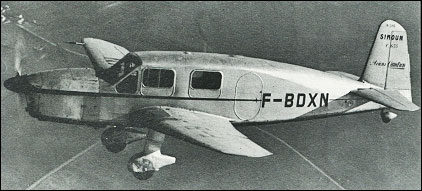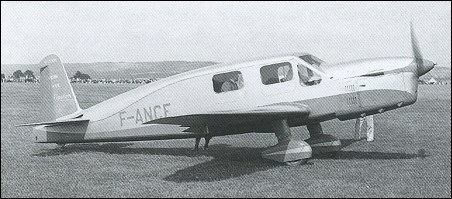 |
Caudron C.630 Simoun1934 |  |
| MILITARY LIAISON, LIGHT TRANSPORT, TRAINER | Virtual Aircraft Museum / France / Caudron |
 |
An outstanding four-seat cabin touring monoplane of the 1930s with an excel lent standard of reliability and comfort, the Caudron C.630 Simoun (Sandstorm) incorporated many technical features developed in designer Marcel Riffard's series of Coupe Deutsche de la Meurthe racers. The experimental C.500 Simoun IV and C.620 Simoun VI were exhibited at the Paris Salon de I'Aeronautique in 1934. The C.620 was intended for the Challenge Internationale de Tourisme competition and its comfortable individual seats, deep windscreen and three large windows on each side of the cabin found greater favour than the more conventional layout and shallow windscreen and windows of the C.500. There was clearly a market for the Simoun with its new Renault six-cylinder engine and, apart from the one-off C.520 and two long-range versions of the C.620 with extra fuel tanks in the cabin, the production C.630 was the next version to appear. The C.630 was an elegant low-wing cantilever monoplane of wooden construction, the wing covered by plywood plus fabric and incorporating flaps that occupied the entire trailing edge inboard of the ailerons. The slab-sided fuselage had light alloy covering for the carefully streamlined curved underside and roof. The non-retractable tailwheel landing gear had cantilever main legs with oleo-pneumatic shock absorbers, the legs, main wheels and castoring tailwheel all enclosed in streamlined fairings. Differential brakes were standard. The prototype C.620 with a 127kW Renault Bengali 6Pfi engine was flown for the first time in October 1934. Only a few months later, in mid-1935, deliveries began of the C.630 series with a 134kW Renault 6Pri (or 6Q-07) driving a Ratier variable-pitch metal propeller. The new type found immediate favour, with orders for some 70 private tourers following. Commercially, 12 C.630s established France's first regular air mail service, each in an elegant light blue finish with a silver arrow along the fuselage side; these belonged to Air Bleu, the air-mail subsidiary of Air France. Air Bleu's first flight from its Le Bourget base was on 10 July 1935. After somewhat erratic early progress, the criss-cross of domestic postal routes resumed in June 1937 and continued until May 1939, establishing a 95 per cent regularity record and carrying over 45 million letters. Other Simouns flew air mail routes in Madagascar. A number of variants followed the C.630, but only the C.635 with a 164kW 6Q-09 or 6Q-15 Bengali engine was built in quantity. Five of the type in red livery equipped the French VIP Escadrille Ministerielle, while during 1935-6 the French services placed initial orders for the militarised C.635M version, 110 for the Armee de l'Air and 29 for the Aeronavale. Other military and naval orders followed, the Simoun being used widely for liaison, as a General Staff transport, and as a transition or navigation trainer. At the outbreak of World War II some 60 civil Simouns were requisitioned by the Armee de I'Air for the hastily formed Sections d'Avions Esta-fettes (air couriers) and Sections d'Avions Sanitaires (air ambulances). Of 103 Simouns captured by the Germans in November 1942, when they took over the Unoccupied Zone of France from the Vichy regime, 65 were used for training and liaison. Large numbers of Simouns flew with the French in North Africa, although the attrition rate was high. Several examples were reported in the UK during the war. Many well-known French pilots of the 1930s used the Simoun in long distance attempts. Among those to gain success were Genin and Robert, who flew a C.635 (named Gody Radio) from Le Bourget on 18 December 1935, 57 hours 36 minutes later landing at Antananarivo in Madagascar, having covered a distance of 8665km. Marie Bastie flying solo took her C.635 Jean Mermoz from Orly on 12 December 1936, reached Dakar in West Africa on 19 December and then crossed the South Atlantic to Natal in Brazil, a distance of 3100km averaging 264km/h. This beat the record held previously by Jean Batten of New Zealand. In another solo flight from France, in August 1937, Maryse Hilsz reached Saigon in less than four days. Other more famous fliers were less fortunate. On a second attempt to reach Tokyo from Paris, Marcel Doret and his partner Micheletti made an emergency landing in Japan and were badly hurt. The great airman-poet Antoine de Saint Exupery, attempting to reach Tierra del Fuego from New York in 1937, crashed on take-off at Guatemala City and was seriously injured. A number of Simouns remained in flying condition post-war. One was used (on the ground, alas) in the film entitled The Little Prince, appropriately enough a story written by Antoine de Saint Exupery!
Kenneth Douglas, e-mail, 07.11.2021  John Bradford John BradfordThe Serial number for the US. Naval Attaché Caudron Simoun 635M was #0725
|  All the World's Rotorcraft | ||||||||||||||||||||||||||||||||||||||||||||||||||||||
 |

|

20
reply